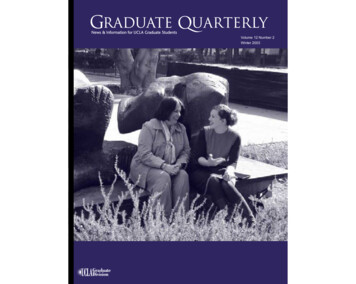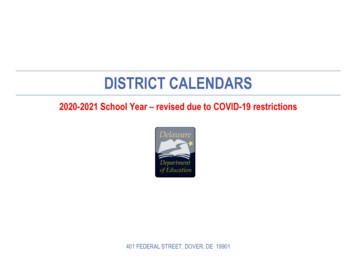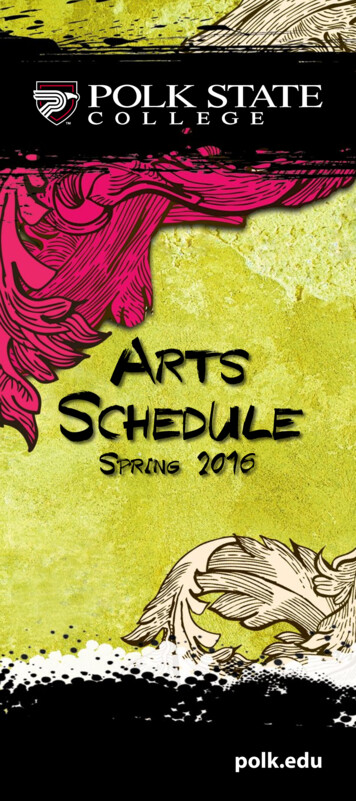
Transcription
Volume 12 Number 2Winter 2003WINTER 20031
Table of ContentsESSAGE FROM THE DEANCopyright 2003Regents of the University of CaliforniaFEATURE ARTICLESDEAR GRADUATE STUDENT:4CSUCLA8Warning SignsThe connections between UCLA and theCalifornia State University system benefit allDean’s OfficeElsewhere on campus, the Coppola One-Act Play Marathon provides an opportunity for students inplaywriting to stage their works and for directors, many of them in the Film Department, to try their hand at liveperformance. Both groups benefit from the opportunity to work, not only with each other, but also with the actorsthey will depend on as they build careers.We also commend to your attention our feature story: The web of connections between UCLA andcampuses of the California State University is bearing fruit for both partners in the educational enterprise. Manyof CSU’s finest graduates are pursuing Master’s and doctoral studies at UCLA, and many of our finest graduatestudents are going on to careers as CSU faculty. This is a relationship that the Graduate Division is devoting considerable attention to fostering.As you go back to your books, I want to strongly encourage all students to engage in socialization activities early and often in your graduate career. Remember that professional socialization is part of what you’re herefor, too.Claudia Mitchell-KernanVice Chancellor, Graduate Studies2G RA DUA TE Q UA R T E R L YClaudia Mitchell-Kernan Vice Chancellor, Graduate StudiesDean, Graduate DivisionDesign Media Arts students rack up the awardsdesigning a sign that would warn people aboutradioactive waste buried in the desertJim Turner - Assistant Vice ChancellorPhillip ChanningPhillipChanningThe kind of learning that’s transferred via books and lectures is onlyone part of graduate education. Arguably the more crucial part is developinga professional persona consistent with the standards of one’s chosen field.In other words, you don’t just learn biology, you learn how to be a biologistor a social scientist, a linguist or a lawyer.This is what we call professional socialization: initiating new recruitsinto the rules and behaviors sanctioned by the discipline. Part of this is learning the techniques of research in various fields and strategies for sharingthe results: writing articles, conference papers, and even books. However,socialization is also learning how to interact: meeting colleagues in professional groups, becoming a citizen of academic communities, working withteams in science laboratories and other research groups.This issue of the Graduate Quarterly provides a number of illustrations of how graduate students arelearning to be future professionals in their fields. For the majority of graduate students, those looking forward tocareers as professors in a range of academic settings, learning the skills that make a fine teacher is a crucial part ofgraduate education. We describe five young scholars who have been honored for distinguished work as teaching assistants in their respective departments. All have developed interesting communication and curricular strategies, buteven more prominently they share a commitment to their students, not as a class but as a collection of individualswith different needs. They make personal connections, and that makes all the difference.We also talked to students whose professional socialization takes a rather different and somewhat moreglamorous form than the traditional journal article or conference poster. In the Design Media Arts Departments,first-year students have been challenged through class assignments to prepare and submit work for internationaldesign contests. At least one has taken home prize money for what began as homework. Presenting work in competition is a key element of design careers, and our students are getting some practice.10Shirley Hune - Associate Dean,Graduate ProgramsThe Power of CollaborationGraduate student writers and directors work together with actors in the Francis FordCoppola One-Act MarathonJohn V. Richardson, Jr. - AssociateDeanWilliam H. Worger - Associate DeanGlen Winans - Assistant Dean,AdministrationGRADUATE STUDENT PROFILES12Martin Janecek - Biomedical Physics14Jennifer Nery - Philosophy16Eric Mayer - Spanish & PortugueseGraduate Outreach, Diversity &FellowshipsChérie Francis - Interim Director1820Michael Mischna - Geophysics and Space PhysicsGraduate Student SupportLynn Gold - Director22Darren Schreiber - Political ScienceInformation TechnologyCarol King - DirectorNEWSGraduate Admissions/Student andAcademic AffairsDaniel J. Bennett - DirectorInstitutional Research andInformation ServicesPamela L. Taylor - DirectorGraduate QuarterlyMary Watkins - EditorJacqueline Tasch - Writer, Featuresand Profiles24Natalie Operstein - Indo-European StudiesThe Distinguished TA AwardsGRADUATE STUDENTACCOMPLISHMENTS27Papers, publications,presentations, performancesPlease send correspondence to:1252 Murphy HallBox 951419Los Angeles, CA 90095-1419graduatequarterly@gdnet.ucla.eduThe Graduate Quarterly is published Fall, Winter, and Springquarters by the UCLA Graduate Division We welcome suggestions and comments, which may be printed selectively in futureissues. Current and archived copies of this publication areavailable to view or to download in PDF format on the GraduateDivision website.On the Cover: Marlene Shelton and Maureen Perkins,participants in the Francis FordCoppola One-Act Marathon.See story on page ten.WINTER 20033
Feature StoryThe relationship between UCLA and the California StateUniversity system appears to be flourishing in ways that wouldplease the designers of the state’s Master Plan.The University of Californiahistorically has provided 24percent of the tenure trackfaculty in the CSU system,and UCLA provides more CSU tenure trackfaculty—773—than any other UC campus. UCLA is the top provider of facultywith UC graduate degrees at nine of thetwenty-three CSU campuses: Bakersfield,Dominguez Hills, Fresno, Fullerton, LongBeach, Los Angeles, Northridge, Pomonaand San Diego.4G RA DUA TE Q UA R T E R L YAt the other end of the pipeline, morethan 7 percent of UCLA’s graduate studentsover the past 10 years have come from CSUcampuses; CSU alumni account for nearly15 percent of graduate students who areunderrepresented minorities.“Maintaining the diversity of the graduate student body is enormously important tous,” says Vice Chancellor Claudia MitchellKernan. “The CSU system has been an important resource and a highly valued ally inour efforts to assure that all of California’sethnic communities have access to UCLA.”“I’m also pleased to hear that manydoctoral recipients, often motivated by theirlove of teaching, are finding homes at CSUcampuses. Besides bringing the rigor andrange of their scholarship to CSUs, they arealso providing a vital link that will build asynergy between UCLA and CSU campusesin the years to come.”Reports from Cal State University andthe UCLA Graduate Division’s InstitutionalResearch and Information Services officeprovide fresh data on UCLA alumni employed as faculty at CSU and CSU alumnienrolled as graduate students at UCLA. Hereare some highlights.Nearly a quarter of CSU’s tenure-trackfaculty have a highest degree (usually aPhD) from UC campuses. UCLA is the biggest single contributor (773), with its alumniaccounting for nearly 8 percent of CSU faculty. UCLA’s dominance covers several fields:humanities and the arts, social science andpsychology, education, and business. Theclosest competitor is UC Berkeley, with 626alumni on CSU faculties.Looking at CSU students who cometo UCLA, their admission and registrationstatistics compare favorably with those ofstudents from other institutions. About 30percent of all applicants are admitted tograduate studies at UCLA, compared to 32percent of CSU alumni. The statistics fornew registrants are even more dramatic.Overall, 48 percent of those admitted actually register for graduate studies at UCLA,compared to 70 percent of CSU alumni. Therates for CSU alumni who are underrepresented minorities are very similar.Cal State Northridge (1,352 students),Cal State Long Beach (926), and Cal StateLos Angeles (853) rank first, second, andthird in the number of CSU students applying to UCLA in the last decade. OtherCSU schools with more than 500 studentapplicants to UCLA during this period areCal State Fullerton, Cal Poly Pomona, SanLinda De Angelo“The diversity of the campus and myFirst, she was a teaching assistant for twoneed to be in a diverse urban envi-years in a service learning course that trainedronment” brought Linda De Angelomentors to work with youth in underserved com-to UCLA when she decided it was time to resumemunities. Then, as part of her role as a studenther college education; she had dropped out afterrepresentative in her division, she contacteda little more than a year. In various jobs she heldstudents who had inquired about the GSEISover the next decade, she saw that the peopleprogram and talked to them about “how to makeshe admired “had a much broader diversity ofdoctoral choices and how to prepare themselvesinformation and experience to draw on,” sheto apply for graduate school.”says. “I wasn’t going to get there from where Iwas at the time.”Linda is still working on her dissertationproposal, but the research may evolve from aAt UCLA, Linda became an English majorpilot study she did assessing how student at-specializing in American literature, but diversitytitudes about affirmative action changed afterremained high on her agenda. “I was interestedthey participated in ethnic studies classes. Anin societal problems, and I felt that in order toexamination of “how students think societymake a difference, I needed to understand thehuman condition in a more comprehensive way,”she says.should be organized” would suit her interests.She hopes to finish in 2004.Meantime, she is consulting with ScrippsWhen she started as an undergraduate,College to help them ensure that the surveyLinda knew she would pursue some sort ofinstruments they use with faculty and studentsgraduate studies, perhaps law school. How-are properly assessing diversity initiatives there.ever, as time went on, she was drawn more toAnd, this year, she holds a position as a gradu-questions about education. “When I went backate student researcher, helping with a Graduateto school, a lot of my friends were puzzled—theyDivision project examining the links betweendidn’t see the economic value of it,” she says.UCLA and the Cal State University campuses“I asked myself what do we think higher educa-that are an important source of UCLA’s diversetion is about? What is higher education’s role instudent body.creating what we call a good society?”Linda has been interviewing CSU alumni whoLinda minored in education as an under-are in UCLA’s doctoral programs about their ex-graduate and moved directly into the Graduateperiences. Although no tapes or transcripts areSchool of Education and Information Sciencesmade, she takes 10 to 15 pages of notes at eachafter obtaining her bachelor’s degree. It was notinterview. Later in the year, she’ll assess the inter-long before she was involved in the outreachview information. As soon as the job was posted,programs that help to ensure UCLA’s diversity.she says, “I knew it was perfect for me.”WINTER 20035
Looking down on the Quad atCal State University, Northridge.(Photography by William Watkins)Doctoral recipients from UCLAwho go on to faculty positionsat CSU campuses are expectedto be natural bridge-buildersbetween the two institutionsDiego State, and San Francisco State.“Our most effective partnership todayis with Cal State Northridge,” says Assistant Dean of the Graduate Division GlenT. Winans. In 1999, a Northridge graduatestudent, Cedric Hackett, developed the Advancement to Graduate Education (AGE)initiative on that campus as part of his master’s degree thesis in education. Each year,Northridge faculty and administrators identify 300 to 400 undergraduates and master’sdegree candidates who are good prospectsfor graduate studies. A delegation of UCLAGraduate Division professionals plus currentgraduate students spend a day at Northridgeto describe successful pathways to graduatestudy and to talk with individual studentsabout opportunities they can pursue.“It’s a marvelous event because thestudents are so focused,” Dr. Winans says.“We’re not just handing out brochures andfree pencils. We’re having substantive conversations about different career paths andsubstantive steps students can take to preparefor, and be successful in, graduate school.”The Northridge model may be used in a proposal to seek foundation funding for similarprograms linking other UC-CSU partners.6G RA DUA TE Q UA R T E R L YMeanwhile, UCLA has developeda Graduate Education Forumat Cal Poly Pomona based onthe successful Northridge experience, andthe relationships with Cal State Long Beach,San Francisco State, and San Jose State aregetting fresh attention. At Cal State LosAngeles, successful National Institutes ofHealth- and National Science Foundationfunded Bridge Programs with UCLA in thelife sciences create close collaborationbetween faculty at both institutions. As aresult, more than a dozen underrepresentedstudents from Cal State Los Angeles havesuccessfully enrolled in doctoral programsat UCLA.“We’re not just handingout brochures and freepencils.”These efforts are part of a larger CSUOutreach Project designed to establish orstrengthen ties between UCLA and CSU campuses, particularly in the Southern Californiaarea. The Graduate Division participates ina program that brings CSU students to UCcampuses for summer research projects,and UCLA faculty are encouraged to spendtime with potential recruits from CSU .Small groups of CSU students in specialacademic advancement programs, such asthe Ronald McNair Scholars Program, CSUPre-Doctoral Program, and the PresidentialScholars Program, also are invited to attendworkshops and meet with faculty and graduate students—either at their home campusor at UCLA.Dr. Winans is building networks withCSU systemwide administrators and campusfaculty, encouraging them to identify students who are good candidates for graduatestudy and to connect them with faculty atUCLA. Examples include a historian at SanFrancisco State, a chemist at San Jose State,a political scientist at Cal State Northridge,and an engineer at Cal Poly Pomona, allof whom have established ties with UCLAcolleagues and passed along promising students. Doctoral recipients from UCLA whogo on to faculty positions at CSU campusesare expected to be natural bridge-buildersbetween the two institutions, and efforts areunder way to encourage greater involvementof these UCLA alumni in building pathwaysto graduate education for CSU students.To support the CSU Outreach Project,the Graduate Division hired two graduatestudent researchers to help gather and assessinformation about the experience of CSUstudents enrolled in graduate programs atUCLA. Linda DeAngelo conducted structured interviews with CSU alumni who arenow in PhD programs at UCLA. Karen Kimheld similar conversations with CSU alumniin master’s degree programs at UCLA and updated and analyzed quantitative data that hasbeen gathered over the last decade. Studentswere asked about their experiences at theCal State campuses and at UCLA and invitedto describe the pathways that led them intograduate studies and to this campus. Theresults are now being analyzed for presentation to academic administrators in the UCand CSU systems. UCLA also has been invitedto share the findings and recommendationsat a CSU systemwide Faculty DevelopmentRetreat for 150 new faculty this spring.At the same time, Linda and Karenare using their contacts with CSU alumni indoctoral programs to recruit participantsfor panels at outreach events on their former campuses and volunteers to meet withCSU students visiting UCLA to learn aboutgraduate programs. In November, a reception was held on campus for CSU alumniinterview respondents, Linda says, “to continue to make them feel welcome.” Theevent was a first step in building a uniquecommunity of CSU alumni at UCLA acrossvarious academic disciplines. Participantswere open about sharing experiences andmaking themselves available to mentor andassist others.This winter and spring Linda and Karenwill survey UCLA alumni currently holdingtenure track faculty positions at selected CSUcampuses to better understand their perspectives on identifying and encouragingCSU students who are likely candidates forgraduate education and helping them prepare for graduate work. The combinationof this input along with student experiencesfrom the recent interviews will allow theGraduate Division to respond with moreappropriate services and better informationfor CSU students.Karen KimWhen Karen Kim saw the GraduateThrough explorations on the Internet, KarenDivision’s posting for a graduatelearned about the Higher Education Research In-student researcher to work on proj-stitute at UCLA and the Graduate School of Edu-ects related to CSU students at UCLA, she ap-cation and Information Sciences, where she wasplied right away. “I didn’t even consider it a job—Iaccepted as a doctoral student in higher educa-was personally committed to this,” she says. “Ition and organizational change. Her courseworkcame from a CSU, and I wanted to help othernow complete, Karen is beginning dissertationCSU students who want to come to UCLA.”research on collaborations between academicDuring the summer, Karen helped to updatefaculty and corporate professionals. She’ll visitand analyze statistics about CSU alumni whothe sites of four new California Institutes of Sci-come to UCLA and the effect they have on theence and Innovation, joint projects between thedemographics of the graduate student body. SheUniversity of California and corporate sponsors.also interviewed dozens of CSU alumni who areHer goal is to see what kind of culture is createdpursuing a master’s degree at UCLA.when people from different professional environ-Karen’s own story has much in common withwhat she heard—career goals brought her toments work together and how this affects—ordoesn’t affect—the science they do.UCLA after a period in the working world. Karen’sWhen it comes time to find a new job, Karenfirst round of higher education focused on phi-wouldn’t mind at all if it included the kind of out-losophy, an undergraduate degree from Loyolareach work she’s done at UCLA. Besides herMarymount University and a master’s degreeGSR position in the Graduate Division, she’sfrom Cal State Long Beach, where her thesisalso been a teaching assistant in a course thatexamined Nietzsche’s philosophy of music.prepares undergraduate education studentsBy the time she finished, she was directorto participate in outreach programs to under-of research for the Directors Guild of America,represented high school students in Southernkeeping track of where movies are being madeas well as copyright and corporate informa-California.Karen knows from personal experience thattion. Because she “loved doing research,” sheerroneous conceptions can influence decisionswanted some formal education in “how to doabout graduate education. “I never thought oflarge studies, how to do quantitative analysis,applying to UCLA for a doctorate in philosophyhow to do qualitative research.” Moreover, shebecause I didn’t think I would be accepted, com-saw that “I had pretty much maxed myself out”ing from Cal State Long Beach,” she says. Herat the Directors Guild, she says. “I couldn’t seesummer job, Karen says, “was an opportunity formyself doing the same thing for the next thirtyme to help UCLA help students to think aboutyears, even though I absolutely loved the job.”graduate school. I think it’s wonderful that UCLAwants to build these partnerships with CSU.”WINTER 20037
Meet the CBD postdoctoral fellowsWarning SignsIT WAS A CHALLENGING ASSIGNMENT: De-sign a sign that would warn futuregenerations about the perils of aproposed national repository for radioactivewaste in the desert under Yucca Mountain,Nevada. Design Media Arts faculty Jennifer8G RA DUA TE Q UA R T E R L YSteinkamp and Gail Swanlund asked theirstudents to do a proposal as their first project in a class on Tangible Typography.Then they asked their students to submit the proposals to a contest, “UniversalWarning Sign: Yucca Mountain,” sponsored by the Desert Space Foundation, aAshok Sukumaran’s proposal, which won "bestof show", illustrated a site thickly planted withgenetically engineered, cobalt blue yucca plants,whose unnatural color would contrast starkly withthe surrounding desert.nonprofit organization that promotes thearts, humanities, and education in Nevada,partnered with the University of NevadaLas Vegas (UNLV). Competing in contests“gets students out in the world, and also it’sa great line for their resume,” says Professor Steinkamp. In the case of the YuccaMountain project, Professor Swanlund says,the judging panel included “some of the bigthinkers in the art world today . . . I thoughtit would be good exposure for the studentsto get their work into an arena like that.”The contest drew 150 entrants fromaround the world. Two members of theSteinkamp/Swanlund class walked awaywith prizes: Ashok Sukumaran as best ofshow and Fabian Winkler among the honorable mentions. Both men are second-yeargraduate students in the Design Media ArtsDepartment.Rather than creating a conventional sign,Ashok and Fabian submitted proposals thatturned the whole Yucca Mountain site intoa symbolic warning. Ashok envisioned a sitethickly planted with genetically engineered,cobalt blue yucca plants, whose unnaturalcolor would contrast starkly with the surrounding desert. Ashok sees it as “putting twodemons together,” nuclear waste and geneticmutation. The blue yucca is a meta-metaphor,he says, one mutant marking the other.Alternatively, Fabian imagined coveringthe site with huge reflectors and “thumpers”similar to those used in the movie, Dune, tocreate a warning on several sensory levels:heat, light, sound, and vibration. “When I firstheard about the plans to bury nuclear waste atYucca Mountain, I thought, is this real or amI just in the wrong movie,” Fabian says. Thus,he hopes people who think his proposal is“unreal” will understand that the reality ofthe situation is still more incredible.The contest was intended to promotepublic awareness rather than to provide anactual plan for the nuclear repository. However, the entries have appeared in severalpublications, and fifteen were displayed atUNLV’s Marjorie Barrick museum in LasVegas, “a setting where you ask yourselfis this reality or just a movie—it wasperfect,” Fabian says. As “best of show,”Ashok took home 1,000, not a bad pricefor something that started out as a homework assignment.The project was well-suited to Ashok,who hopes for a career designing “publicspace rewired, reconstituted, re-imagined.”He was working as an architect when hewas drawn to media art because “I wantedmore forms of expression than walls anddoors.” UCLA’s program was appealing because he found it more art-based than somealternatives.Fabian was drawn to UCLA because theprogram gave students “more freedom tocome up with your own ideas, to conceptualize as well as realize work.” Connectionsto other UC campuses have extended theFabian Winkler and Adriana deSouza e Silva’s strike database strike installation uses a printer, video camera, and database to question the meaning ofcomputer interfaces.opportunities to present his work. Besidesthe Yucca Mountain project, Fabian submitted another work, in collaboration withAdriana de Souza e Silva, that has receivedhonors. The strike database strike installation uses a printer, video camera, anddatabase to question the traditional meaningof computer interfaces. Papers describingtheir work were presented at a conferencein Brazil and at ACADIA 2002.Working with Adriana, “was fun becausewe both came from very different backgrounds,” Fabian says. “My background isinstallation art and interactive real-time environments whereas Adriana has strengths intheory.” Fabian says he “completely dislikesthe competitive model of contests, the ideaof outdoing others, especially in the fieldof the arts. What is important to me is tobuild up a network of persons, institutionsand ideas. . . In attending conferences orexhibiting work I ideally enlarge this network by connecting to others and by seeingand hearing other ideas while presenting myown ideas.”To learn more about theDesign Media Arts program at UCLA, goto www.design.ucla.edu, which also provides web space for students. To learn moreabout the Yucca Mountain contest, go towww.desertspace.org.Ashok Sukumaran and FabianWinkler, Design Media Arts StudentsWINTER 20039
the performance began—no yelling Cut!’and making adjustments either for the actors or for the lighting/sound board operators,” Miranda explains. “So the processinvolved the building of a different kindof trust in each other, one where I had tolet the play slip out of my hands once theshow began.”LOSING CONTROL IS NOT ALWAYSMarlene Shelton and Maureen (Mo) Perkinsoutside of MacGowan Hall. Marlene says of Mo,"She understood that play on so many levelsthat this has been one of the most satisfyingcollaborations I have ever had with a director.THE POWER OF COLLABORATIONThe Francis Ford Coppola One-Act Marathon"WORKING WITH ACTORSIS WHEN THE MAGICAPPEARS," ACCORDINGto graduate student playwright MarleneShelton. “Once I have tinkered with thescript and come up with a final draft, thenit’s all about the actors. They conjure upthese characters I wrote for them,” she says,and—with the director as a guide—“theybring them to life.”10G RA DUA TE Q UA R T E R L YIndeed, while the Francis Ford CoppolaOne-Act Marathon was established fiveyears ago to bring together student playwrights from the Department of Theaterand student directors from the Departmentof Film, much of its power comes fromthis third connection: bringing writers anddirectors from the MFA program togetherwith actors, who are mostly undergraduates.In this case, the graduate students are theones doing the learning.“Working on a Coppola One-Act gaveme an opportunity to dive in and get myhands dirty with the actors—do some really in-depth, intense dramatic work,” saysdirecting student Miranda Yousef. “Whenyou can’t get a close-up, you have to findother ways to achieve the same effect.”Theater and film provide different challenges. “I could not stop the actors onceeasy. The playwright on Miranda’sproduction, Ben Lamoso says, “I was oftenshocked by the choices our actors wouldmake with line readings. I had a certain ideain my mind of what the actors would look,act, and sound like on stage when I wrote theplay. . . . [The actors] would often go places thatI never intended the characters to go—whichwas sometimes exhilarating and other timesterrifying.”Working with actors provided some important lessons. As a writer, Ben learned toestablish a consistent tone, “a unified worldso that the actors could connect with thewavelength of the piece.” His directingpartner, Miranda, learned “how to generate something authentic inside of the actorsthat will inspire them to re-create genuineperformances in accordance with your vision.” Playwright Rose Martula worked tofind “that common language when talkingabout the actors’ characters or what youmeant when you wrote this certain line orcertain point.”Of course there are practicalities, too.“I learned how valuable clarity and brevityin writing can be when actors have only afour-week rehearsal process,” Ben says.That four-week rehearsal and the performances came at the end of a quarter-longcourse called “Script Development Workshop.” Playwriting students had writtentheir one-act plays as part of a first-yearcourse. The student directors learned theatrical techniques in a class offered in springquarter, and four were selected to participatein the Coppola program. When writers anddirectors came together this fall, they pickeda cast, rehearsed scenes, talked with designstudents, and got ready for the workshopproductions presented in Macgowan Halljust before and after the Thanksgivingbreak. Design students and actors also getcourse credit for their work.The Coppola program was devisedby faculty and administrators in film andtheater, inspired by film director FrancisFord Coppola’s insight. He has said thathe learned his cinematic skills not only asa graduate student in film but also as anundergraduate in theater at UCLA.“He liked the idea of the film-directingstudents being challenged by having to direct a play in regular time and in sequentialorder,” says Edit Villarreal, chair of the playwriting program. Coppola lent the programhis name but does not fund it. Other goalsof the course are a cross-pollination amongtheater and film students, along with opportunities to network that might lead toother projects.EACH YEAR, ONE OR MORE WRITER/director pairings decide to continuetheir collaboration. “One of the concernsevery playwright has is that the directorwill not understand the play and will takeit in a direction that doesn’t work,” saysMarlene. “This was never the casewith Mo [Maureen Perkins]. Sheunderstood that play on somany levels that this hasbeen one of the mostsatisfying collaborationsI have ever had with adirector.”Even if no longterm partnership isformed, student playwrights and studentdirectors learn abouteach other’s techniques. “In film you tellthe story through visuals, and in the theater,you have to tell the story through language,”says Jose Luis Valenzuela, part of the facultyteam that taught theater techniques to thestudent directors last spring.WORKING WITH HIS DIRECTINGpartner, Miranda, Ben says, “it wasimportant that we were always aware of thatdistinction and that we talked about it.” Inreturn, Miranda says she “enjoyed workingwith [Ben] and helping him to refine his playto reflect his visi
faculty have a highest degree (usually a PhD) from UC campuses. UCLA is the big-gest single contributor (773), with its alumni accounting for nearly 8 percent of CSU fac-ulty. UCLA's dominance covers several fi elds: humanities and the arts, social science and psychology, education, and business. The closest competitor is UC Berkeley, with 626 alumni on CSU faculties. Looking at CSU .











